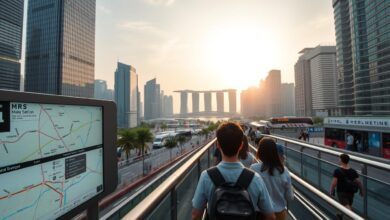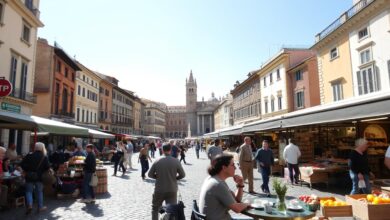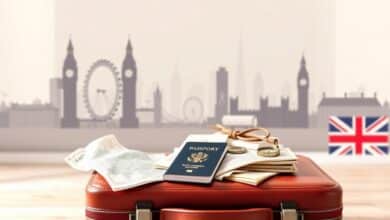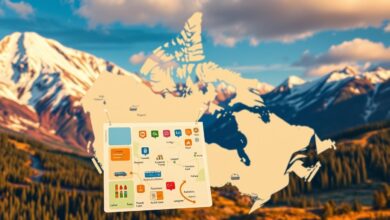Germany on Foot and Rail: Step-by-Step Guide for Moving Around Efficiently
Traveling through Germany is a rich experience. Knowing the country’s public transportation system is key to enjoying your trip.
Anúncios
This guide covers trains, buses, trams, and biking paths.
Germany’s networks are well-connected. They help you move through cities and countryside easily. These tips will help you travel smoothly, making the most of your time in Germany.
Understanding Germany’s Public Transportation System
Germany has a wide and efficient public transport system. It makes traveling around the country easy. You can use trains, trams, buses, and metros to get around. Each one has its own benefits, making travel convenient for everyone.
You will be redirected to another website
Here, you’ll learn about the different types of public transport. You’ll also find out how to buy tickets and read timetables.
Types of Public Transport
Germany’s public transport is varied to meet different needs. The main types are:
- Trains: Great for long trips between cities, Germany’s trains are fast and cover a lot of ground.
- Trams: In cities, trams are a good way to see local sights and neighborhoods.
- Buses: Buses reach places trains and trams don’t, making them key for full travel.
- Metros: In big cities, metros offer quick travel with many services.
How to Purchase Tickets
You can buy tickets for public transport in Germany in several ways. Here are the options:
- Ticket Machines: At stations, machines let you buy single rides, day passes, or regional passes.
- Mobile Apps: Many cities have apps for buying tickets and planning trips.
- Counter Services: At some stations, counters offer help for buying tickets.
Navigating Transport Timetables
Knowing how to use transport timetables is important for smooth travel. Timetables show when trains, trams, buses, and metros run. Key things to note are:
- Frequency: How often services run changes by location and time.
- Connections: Look out for transfer points when switching between transport types.
- Apps and Websites: Apps can make it easier to find current schedules and routes.
Getting Around by Foot: Exploring City Centers
Walking is a great way to see Germany’s city centers. It lets you connect with lively streets and find historic spots, local shops, and cultural places. With travel tips for Germany, you can make the most of your walks in cities like Berlin, Munich, and Cologne.
Best Walking Routes in Major Cities
Germany’s big cities have amazing walking paths. In Berlin, you can walk the East Side Gallery and see cool murals. Munich’s Marienplatz is beautiful, with its stunning buildings. Cologne’s Rhine river promenade has great views, making your walk even better.
Benefits of Walking in Germany
Walking in Germany has many benefits. It’s good for your heart and makes you feel better overall. Plus, you can find hidden spots, local cafés, and street performers. This makes your trip more special.
Safety Tips for Pedestrians
It’s important to stay safe while walking. Know the rules for crossing streets and where you can walk. Always be careful, especially in crowded places. Using paths and waiting for signals helps keep you safe and makes your trip worry-free.
Utilizing the Rail Network
Germany has a vast and efficient rail network. It offers many ways to travel across the country. Knowing the different rail services is key for planning your trip.
Overview of Germany’s Rail Services
The Deutsche Bahn (DB) runs most of the trains. They connect big cities and small towns. You can count on on-time trains, modern cars, and easy booking.
The network suits many travel styles. It’s a favorite among both locals and tourists.
High-Speed Trains: DB ICE and IC
For fast travel, the ICE and IC trains are perfect. The ICE goes up to 300 km/h. It links places like Berlin, Munich, and Frankfurt quickly.
The IC is a bit slower but still efficient. It’s great for popular routes.
Regional and Local Train Options
For exploring off-the-beaten-path areas, try S-Bahn and regional trains. They often connect with other transport. They’re good for those watching their budget.
| Train Type | Speed (km/h) | Key Routes | Typical Duration |
|---|---|---|---|
| ICE | 300 | Berlin to Munich, Frankfurt to Stuttgart | 4-6 hours |
| IC | 200 | Berlin to Cologne, Hamburg to Stuttgart | 5-7 hours |
| S-Bahn | 80 | Berlin area, Munich area | 30-60 minutes |
| Regional Train | 120 | Various routes connecting smaller towns | 1-2 hours |
Tips for Navigating the Metro Systems
Traveling through Germany’s metro systems is easy. Cities like Berlin and Munich have big, organized metro networks. Knowing how to use maps and buy tickets makes traveling better. Also, knowing the local customs helps you move around smoothly.
Overview of Major Metro Systems
Germany’s metro systems connect cities well. Berlin’s U-Bahn and Munich’s U-Bahn are great examples. They have modern features like real-time updates and clear signs. People like how reliable they are, making planning trips easier.
How to Transfer Between Lines
Switching lines is key to easy travel in Germany. Most stations have clear signs for transfers. Knowing the layout helps, especially when it’s busy. Here are some tips:
- Look for transfer symbols on maps
- Listen to announcements about transfers
- Give yourself extra time during rush hours
Metro Etiquette in Germany
Following metro etiquette makes your ride better. Respect personal space and quiet areas. Being polite to others makes the ride more enjoyable. Here are some tips:
- Keep voices down and avoid loud music
- Give up seats to those who need them
- Stand on one side of escalators
Biking in Germany: A Sustainable Option
Biking is a big part of Germany’s way of getting around. It’s good for the planet and makes traveling fun. This part talks about the best cities for biking, how to rent bikes, and safety tips for cyclists.
Popular Cities for Cycling
Berlin, Hamburg, and Munich are top for biking. They have lots of bike lanes. This makes it easy to ride through the city.
Each city offers a special biking experience. You can ride by lakes in Munich or explore Berlin’s history.
Renting Bikes: What to Know
Renting bikes in Germany is easy. You can use bike-sharing programs like Nextbike and Lime. They cost between €8 to €15 a day.
Many places to rent bikes are near tourist spots. They offer both regular and e-bikes. This makes exploring easier.
Safety Guidelines for Cyclists
It’s important to follow safety rules when biking. Always wear a helmet and use bike lanes. Knowing the local traffic rules is key.
Signal your turns and watch out for pedestrian zones. Each city has its own rules. Following these tips makes biking safer and more enjoyable.
Understanding Travel Passes and Discounts
Planning a trip to Germany can be better with travel passes and discounts. There are many passes for different needs, making travel easy. This part talks about popular passes and travel tips for Germany, helping you enjoy your trip.
Overview of Popular Travel Passes
The German Rail Pass lets you travel by train without limits for a set time. Regional travel cards, like the Bavaria Ticket, save money in specific areas. These passes help you travel cheaply and easily, making your trip better.
Discounts for Students and Seniors
Students and seniors can save on travel with special discounts. Train operators offer big reductions. Student IDs can also get you cheaper local passes. These deals are great for budget travel in Germany.
Group Travel Benefits
Traveling in groups has its perks. Many transport services give discounts for groups. Booking early or using group tickets can save a lot of money. This makes trips with friends or family more fun.
Regional Transport: Buses and Trams
Buses and trams are key in Germany’s transport network. They connect areas not well served by trains. For those exploring Germany, these options are crucial, reaching both cities and countryside. This part talks about the importance of buses and trams, when to use them, and tram systems in cities.
Importance of Buses and Trams
Buses and trams are vital for Germany’s public transport. They ensure travel across cities and regions is reliable. They connect neighborhoods, suburbs, and small towns to big cities, helping both locals and visitors.
Buses are great when train services are not available. They are essential for daily commutes and for those wanting to see places not many visit.
When to Use Bus Over Train
Deciding between bus and train depends on the distance and service frequency. Buses are better for short trips, especially in cities with many stops. If you’re going a short distance or there are few train options, the bus might be quicker.
However, for longer trips where trains are faster, trains are the better choice.
Understanding Tram Systems
Tram systems differ from city to city, offering both efficiency and scenic views. Cities like Berlin, Munich, and Stuttgart have big tram networks. They make traveling through cities easy and fun.
They give easy access to main attractions and help avoid traffic. Knowing the local tram maps and schedules makes traveling in these cities even better.
Mobility for Tourists: Essential Tips
Traveling in Germany is an exciting adventure. To make it even better, tourists can use many helpful resources. These tips will help you move around Germany easily.
Travel Apps and Resources
Downloading travel apps can greatly help you navigate Germany’s transport system. Here are some useful apps:
- DB Navigator: Great for checking train times and buying tickets.
- Google Maps: Shows routes for walking, biking, and public transport.
- Citymapper: Gives detailed travel advice and live updates.
Language Tips for Navigating Transport
Even though many Germans speak English, knowing some German transport words helps. Here are some useful phrases:
- Wo ist die nächste Haltestelle? (Where is the nearest stop?)
- Ich hätte gerne ein Ticket. (I would like a ticket.)
- Wann fährt der Zug? (When does the train leave?)
Accessibility Options
For tourists with disabilities, accessible transport is key. Germany makes travel inclusive with:
- Low-floor buses and trams for easy access.
- Accessible train stations with elevators and ramps.
- Help services at major stations for easy travel.
Using these mobility resources can make your trip to Germany better. Making smart choices leads to a smoother and more fun journey across this diverse country.
Environmental Considerations in Transportation
Germany is a leader in sustainable travel, showing its dedication to the environment. It offers efficient ways to get around and helps protect our planet. This guide explains how Germany’s public transport and vehicle tech meet environmental goals.
Germany’s Commitment to Sustainable Travel
Germany has made big investments in public transport and infrastructure. Cities have introduced eco-friendly transport systems to cut emissions. This effort makes public transport appealing to both locals and tourists.
Use of Electric and Hybrid Vehicles
Germany is adding electric and hybrid vehicles to its transport options. Cities like Berlin and Munich are growing their electric bus fleets. This move reduces carbon emissions and makes cities quieter and cleaner.
Impact of Public Transport on Carbon Footprint
Using public transport cuts down on carbon emissions compared to driving. More tourists are choosing trains, buses, and trams. This choice helps reduce greenhouse gas emissions and supports sustainable travel.
Travel Etiquette in Germany
Knowing how to act in Germany is key for a great trip. Following some basic rules can make your journey smoother. It also shows respect for the culture, especially when using public transport.
Dos and Don’ts of Using Public Transport
- Do always validate your ticket before boarding.
- Do offer your seat to elderly or disabled passengers.
- Don’t speak loudly or play music without headphones.
- Don’t block the aisles with bags or belongings.
Interaction with Locals
Talking to locals can make your trip even better. Saying “Guten Tag” to people you meet is a nice gesture. Learning a few German words shows you care about their culture.
Always be polite and use formal titles unless told otherwise. This shows respect and makes a good impression.
Respecting Quiet Zones
Some parts of public transport in Germany are quiet zones. It’s important to follow the signs and keep it quiet. This makes the trip better for everyone.
Safety and Security Guidelines
Traveling in Germany is exciting, but safety is key. This part of the guide helps you keep your stuff safe on public transport. Being aware and prepared makes your trip better.
Keeping Personal Belongings Secure
When using public transport in Germany, watch your belongings closely. Here are some tips:
- Use bags with zippers and keep them closed.
- Carry valuables such as passports and electronics close to the body.
- Be cautious in crowded areas where pickpockets may operate.
- Avoid displaying expensive items like jewelry and high-end gadgets.
Emergency Numbers and Assistance
Knowing important emergency numbers is crucial. In Germany, you should remember:
| Service | Emergency Number |
|---|---|
| Fire Department | 112 |
| Police | 110 |
| Medical Emergencies | 112 |
| Road Assistance | 0800 111 11 22 |
What to Do in Case of Lost Items
It’s upsetting to lose something important. If it happens on public transport in Germany, here’s what to do:
- Report the loss to the transport authority’s lost and found department as soon as possible.
- Provide a detailed description of the lost item.
- Inquire about the procedure for recovering the item if it turns up.
- Consider making a police report if valuable items are lost.
Planning Multi-City Travel in Germany
Traveling across Germany needs good planning to enjoy every moment. Multi-city trips let you dive into each place’s culture and sights. Itineraries show you must-see spots like Berlin’s Brandenburg Gate and Munich’s lively streets.
These plans make your trip smooth and fun. They help you see the best of Germany without hassle.
Suggested Itineraries for Efficient Travel
Start in Berlin, then go to Dresden, Nuremberg, and end in Munich. This route lets you see each city’s special culture and food. You’ll visit art galleries, historical sites, and try local dishes.
These tips help you see amazing sights and travel less. You’ll have a great time exploring Germany.
Combining Modes of Transport
Using different transport ways makes traveling in Germany better. High-speed trains cover long distances fast. Local trolleys and buses are great for city trips.
This mix saves time and adds excitement. Being open to different transport can lead to new discoveries and a deeper love for each city.
Key Considerations for Long-Distance Travel
Book early for long trips to get the best deals. Know the transport schedules and any transfer needs. Planning ahead reduces stress and boosts your trip’s fun.
Good planning and using various transport options make your journey rich. You’ll enjoy Germany’s varied landscapes and lively cities more.
FAQ
What types of public transportation are available in Germany?
Germany has many public transport options. You can find trains, trams, buses, and metros. They connect cities and towns well. This makes traveling easy across the country.
How can I purchase tickets for public transportation in Germany?
You can buy tickets at machines, online, or at sales points. There are single-ride tickets, day passes, and regional passes available.
Are there any travel apps that can assist with navigating transportation in Germany?
Yes, there are apps like DB Navigator for trains and Google Maps for navigation. Local apps also help with city transit. These apps are key for planning your trip.
What are the benefits of walking in major cities in Germany?
Walking lets you see cultural spots and enjoy views. It’s good for your health and the environment. It also lets you see local life up close.
How does the rail network operate in Germany?
Deutsche Bahn (DB) runs Germany’s rail network. It has fast trains like ICE and IC, and local trains. These connect places well.
What should I know about metro systems in major German cities?
Cities like Berlin and Munich have detailed metro systems. Knowing how to switch lines and local rules helps. It makes traveling smoother.
Are there bicycle rental options available in Germany?
Yes, cities offer bike rentals. This includes bike-sharing programs. Renting bikes is a green way to see places at your own pace.
What travel passes and discounts are available for tourists?
Tourists can use passes like the German Rail Pass for savings. There are also discounts for students and seniors. This makes travel cheaper.
When should I take a bus instead of a train in Germany?
Buses are good for short trips or where trains don’t go. Knowing schedules helps pick the best transport.
What are some essential safety tips for traveling on public transport in Germany?
Keep valuables safe and stay alert. Follow safety rules. Knowing emergency numbers helps in case of trouble.
Published on: 12 de April de 2025

Arturo González
Arturo González is the founder and lead writer of DebxCred.com, a platform created to help people make smarter and more informed financial decisions. With a degree in Business Administration and a specialization in Financial Marketing, Arturo built a solid corporate background before deciding to share his knowledge in a practical, easy-to-understand way.
Driven by a genuine passion for finance and education, Arturo turned DebxCred.com into a trusted source for detailed reviews of financial products, digital banking tools, and practical financial education — empowering readers to take control of their money with confidence.
In his free time, Arturo finds balance and inspiration while surfing — a hobby that reflects his calm yet determined approach to helping others build a healthier and more prosperous financial life.






